
Inverclyde is one of 32 council areas used for local government in Scotland. Together with the East Renfrewshire and Renfrewshire council areas, Inverclyde forms part of the historic county of Renfrewshire, which currently exists as a registration county and lieutenancy area. Inverclyde is located in the west central Lowlands. It borders the North Ayrshire and Renfrewshire council areas, and is otherwise surrounded by the Firth of Clyde.

Greenock is a town in Inverclyde, Scotland, located in the west central Lowlands of Scotland. The town is currently the administrative centre of Inverclyde Council. It is a former burgh within the historic county of Renfrewshire, and forms part of a contiguous urban area with Gourock to the west and Port Glasgow to the east.
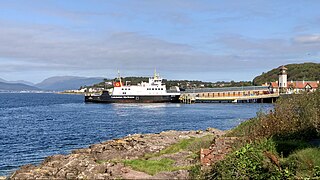
Wemyss Bay is a village on the coast of the Firth of Clyde in Inverclyde in the west central Lowlands of Scotland. It is in the traditional county of Renfrewshire. It is adjacent to Skelmorlie, North Ayrshire. The town and villages have always been in separate counties, divided by the Kelly Burn.

Inverclyde was a parliamentary constituency of the House of Commons of the Parliament of the United Kingdom. It replaced Greenock and Inverclyde and the Port Glasgow and Kilmacolm areas from West Renfrewshire for the 2005 general election.

Inverkip is a village and parish in the Inverclyde council area and historic county of Renfrewshire in the west central Lowlands of Scotland, 5 miles (8 km) southwest of Greenock and 8.1 miles (13 km) north of Largs on the A78 trunk road. The village takes its name from the River Kip and is served by Inverkip railway station.

Inverkip power station was an oil-fired power station on the Inverclyde coast, Firth of Clyde, west coast of Scotland. It was closer to Wemyss Bay than Inverkip, and dominated the local area with its 236 m (774 ft) chimney, the third tallest chimney in the UK and Scotland's tallest free-standing structure. In common with other power stations in Scotland it lacked cooling towers; instead, sea water was used as a coolant. The station consisted of three generating units with a combined total rating of 2028 megawatts (MW).

Greenock West railway station is a station in Greenock, Scotland, located on the Inverclyde Line which runs from Gourock to Glasgow Central. The route is currently operated by ScotRail under the auspices of Strathclyde Partnership for Transport. Each service to and from Glasgow on the Inverclyde Line stops at this station.
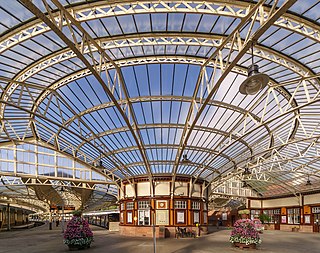
Wemyss Bay railway station serves the village of Wemyss Bay, Inverclyde, Scotland. The station is a terminus on the Inverclyde Line, about 26 miles (42 km) west of Glasgow Central. The station incorporates the Caledonian MacBrayne ferry terminal connecting mainland Scotland to Rothesay on the Isle of Bute. The station is managed by ScotRail.
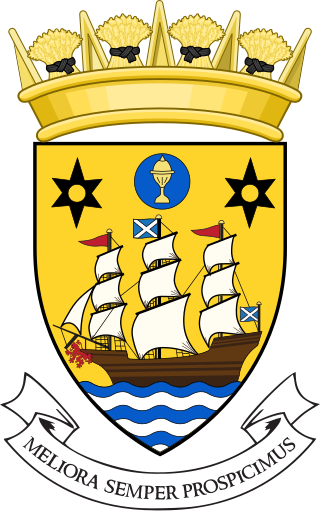
Inverclyde Council is one of the 32 local authorities of Scotland, covering the Inverclyde council area. In its current form the council was created in 1996, replacing the previous Inverclyde District Council which existed from 1975 to 1996.
Wellington Academy was a secondary school at Dempster Street in Greenock, Scotland serving the Eastern and Central areas of the town. In 2007 it merged with Greenock High School to form Inverclyde Academy.
The Greenock and Wemyss Bay Railway was a railway owned by the Caledonian Railway, providing services between Greenock and Wemyss Bay.
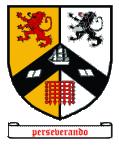
Buckhaven High School was a six-year co-educational non-denominational comprehensive school in Buckhaven, Fife, Scotland. In the past, Buckhaven was Levenmouth's high school for pupils who passed their qualifying exam. The school's motto was Perseverando.

St Columba's High School is a co-educational six-year Roman Catholic, comprehensive secondary school, located next to Tower Hill Gourock, Inverclyde, Scotland. The school serves south west Greenock, Gourock, Inverkip and Wemyss Bay. The current enrolment (2018) is 682 pupils, with notable alumni including actor Martin Compston, as well as current MSYP for Inverclyde, Matthew Quinn.
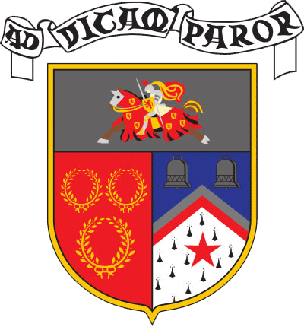
Bell Baxter High School is a non-denominational comprehensive school for 11 to 18 year olds in Cupar, Fife, Scotland. Founded in 1889, it educates over 1,500 pupils mainly from the surrounding villages.

Inverclyde Royal Hospital is a district general hospital in Greenock which serves a population area of 125,000 consisting of Inverclyde, Largs, Isle of Bute and Cowal Peninsula. Inverclyde Royal Hospital is one of three main hospitals in the South Clyde area, alongside Vale of Leven Hospital in Alexandria and Royal Alexandra Hospital in Paisley and is managed by NHS Greater Glasgow and Clyde.

Ardgowan Castle, originally called Inverkip Castle, is located in the Private Garden of "Ardgowan House, Castle & Gardens" near Inverkip, Scotland. It is near the Firth of Clyde in Inverclyde, in the former county of Renfrewshire. The three-storey ruin of the 15th century tower house is protected as a category B listed building.

Spango Valley is a steep sided valley to the south-west of Greenock, Scotland. It runs approximately south west to north east for around 2.4 km (1.5 mi) from the confluence of the Spango Burn and Kip Water near Dunrod Farm, to Ravenscraig at the present day Aileymill Gardens. A small stream known as the Spango Burn, runs along the valley floor. The originally meandering burn has been channelised and straightened for much of its length as it runs south west through the valley.

Inverclyde South West is one of the seven wards used to elect members of the Inverclyde Council. It elects three Councillors.


















